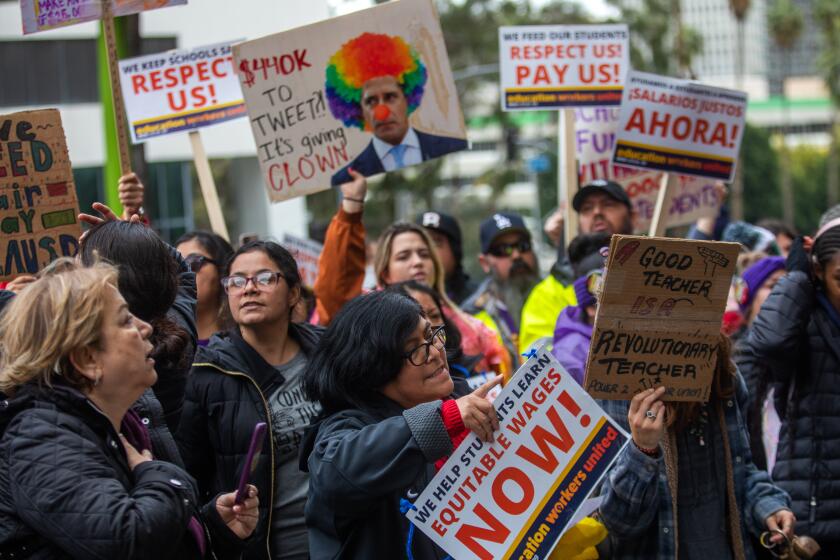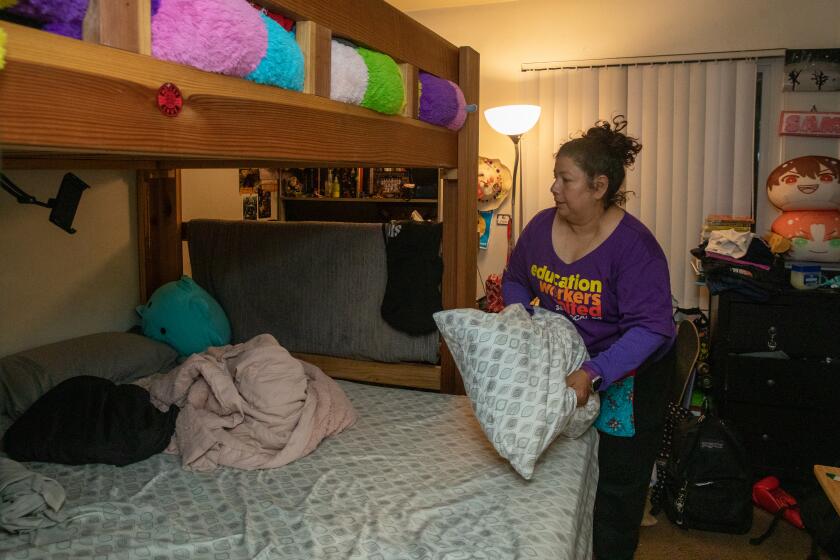New contract would raise average L.A. teacher salary to $106,000 and lower class size

- Share via
The Los Angeles school district and the teachers union have reached a tentative agreement that provides a 21% wage increase over about three years, raising the average teacher salary to $106,000 while averting the potential of a second strike this school year.
If approved by members of United Teachers Los Angeles, the salary for teachers would range from about $69,000 to $122,000. Teachers who take on extra work responsibilities could earn more, a boost aimed at addressing the high stress and high cost of living that many teachers say they are struggling with, especially since the pandemic.
Hard-to-staff positions such as nurses would see additional salary hikes.
“This agreement with UTLA is a necessary step not only to make Los Angeles Unified the district of choice for families but also the district of choice for teachers and employees,” Supt. Alberto Carvalho said.
Union leaders characterized the negotiations as a successful battle to win concessions to benefit members and the community on such issues as smaller classes, working to expand the number of housing units for low-income families, special programs for Black students and curriculum on climate change.
And many parents were relieved.
“I feel like a huge weight has been lifted,” Jenna Schwartz, co-moderator of the Facebook group Parents Supporting Teachers, said in a Facebook post. “I hope that each of our wonderful teachers and all UTLA members goes to school today feeling uplifted and embraced!”
The settlement will bring a modicum of labor stability to the nation’s second-largest school district, which was battered by the COVID-19 era and shut down by strikes on each side of it. Teachers walked out for six days in January 2019 and joined the district’s other mega-union, representing support staff, for a three-day strike in March. Another teachers strike was not out of the question — either for this school year or in the fall.
The deal follows two marathon negotiating sessions — the Sunday meetings stretched till 3 a.m. and Monday’s went overnight until about 6 a.m., according to a top union negotiator. For the talks, the union expanded its bargaining team to as many as 75 participants, necessitating the use of the auditorium in the union’s downtown L.A. building to meet with the much smaller district team.
California workers from fast food to school staff are demanding better wages and benefits through legislation backed by unions.
Often, the district was in agreement with the union on politics, but objected to including such matters in the contract. A contract provision, if not followed, could allow the union to initiate a grievance process. As a result, the union would have leverage if, for example, the district fails to maintain staffing for the Black Student Achievement Plan.
“The best part is: Parents, students and the community have had a voice from the beginning,” said union bargaining co-chair Arlene Inouye. “They shared with us what they needed and wanted. And this contract reflects so many aspects of what we heard.”
While the deal was celebrated on both sides of the bargaining table, there is a question of affordability.
School board President Jackie Goldberg said that the district negotiating team remained within the spending limits authorized by the Board of Education. Carvalho noted that the deal is more affordable because it is spread out over three years:
- 3% retroactive to July 1, 2022
- 4% retroactive to Jan. 1
- 3% effective July 1, 2023
- 4% effective Jan. 1, 2024
- 3% effective July 1, 2024
- 4% effective Jan. 1, 2025
Officials have not always crafted affordable deals. A 1989 settlement for a 24% raise over three years was followed by a 10% pay cut. The Great Recession of 2008 led to funding cuts and layoffs.
The skeptics include professional union watcher and critic Mike Antonucci.
“The only plus for the district in this deal is that it stretched out the increases to three years,” Antonucci said. “I read this as: hiring more employees, paying everyone 21% more — all amid historic declines in enrollment. So, no, I don’t believe the district can afford it.”
Over the coming years, the district also must manage multibillion dollar unfunded liabilities for retiree health benefits as well as steep state-pension costs, said Lance Christensen of California Policy Center, which advocates for union-represented employees to opt out of paying dues.
But union leaders pointed to a record $5-billion reserve — and brushed off district warnings that much of this stockpile was one-time funding that was risky to use for ongoing expenses.
“Instead of padding their reserves,” said Inouye, “put it now into the schools and to our students and members.”
On top of the 21% increase, the package also calls for additional pay in hard-to-staff jobs. These include an added $20,000 raise for nurses and $3,000 for school psychologists, psychiatric social workers, attendance counselors and other special services providers. All of these workers are represented by UTLA.
The agreement comes after L.A. Mayor Karen Bass intervened to mediate the protracted dispute that led to a three-day strike and LAUSD school closures.
“The $20K increase for nurses looks promising, but I don’t think it will address the nursing issue,” said Sumithra Rao Roberts, a parent at Welby Way Elementary in the west San Fernando Valley. “There is a nursing shortage. So to solve our RN crisis, we need a more creative solution than just money.”
The pact also includes an extra $2,500 ongoing increase for special education teachers and a $1,500 ongoing raise for early education teachers. There’s long been a shortage of permanent teachers for students with disabilities. The early education field is growing with the expansion of transitional kindergarten as an optional grade for all 4-year-olds. Teachers of 3- and 4-year-olds have worked on a separate and lower salary scale, Inouye said.
On Tuesday, district officials expressed solidarity with teachers; a union statement referred to bargaining frustrations.
“While Carvalho and the district spent the past year ignoring and undermining educators, students, and parents, we were fighting for a fair contract that meets the urgent needs of today and builds a strong foundation for public schools,” a union release stated.
The union credited its participation in the three-day joint strike in March that was led by Local 99 of Service Employees International Union with helping to bring about the tentative agreement. Local 99 represents the largest number of non-teaching employees, about 30,000 workers. The teachers union represents about 35,000.
Teachers gave up 1.7% of their pay for this year by going on strike.
For many L.A. Unified workers who are on strike, the crux of the fight is the ability to live decently in L.A., where the cost of housing exerts a brutal burden.
In its release, the union, like the district, led with the salary increase, but it also called attention to class-size reductions.
These reductions are small, about two students per class over the life of the contract, but continue ongoing efforts to make classes smaller. The deal prioritizes the district’s 100 most “fragile” schools for the reductions, using a designation based on low student achievement and other factors.
“Parents and teachers overwhelmingly agree that we need substantial districtwide class-size reductions,” said parent Christie Pesicka, a spokesperson for United Parents Los Angeles. “A two-student reduction from maximum phased-in over time is not adequate.”
Pesicka applauded the compensation gains but questioned how much historic funding levels have benefited schools and families.
“Parents at many of our schools fundraise to pay for basic operating costs, staff, teaching assistants, crossing guards, sanitation, assistant principals, computers, PE, art, music, etc. If the district has all this money, why aren’t they funding staff and programs?”
Under the deal, caseloads for professionals such as counselors will also be reduced, but they remain large. The maximum caseload for a secondary school academic counselor would be lowered from 750 to 700.
Local 99 reached a tentative agreement March 24 that was subsequently ratified by its members. Other labor unions have yet to settle, including clerical workers, administrators and school police officers.
The Board of Education on Tuesday unanimously approved the agreement with Local 99, which represents custodians, cafeteria workers, bus drivers, teacher aides, special education assistants and security aides.
Local 99 Executive Director Max Arias called the approved contract “a significant step forward that recognizes the essential role that school workers play in student learning.”
More to Read
Sign up for Essential California
The most important California stories and recommendations in your inbox every morning.
You may occasionally receive promotional content from the Los Angeles Times.














